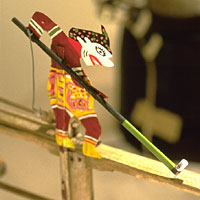|
|
|
||||||
|
|
|||||||
|
This is a GATEWAY of communication. There is a voice within the Gamelan, the sound "ning." This sound also carries a philosophical meaning, that of purity, clarity of thought, and emotion.
|
 |
|
|
Because of the Gamelan's open nature to outside influences such as mentioned above, one could easily term the Gamelan a form of installation art. In its general form, the Gamelan is seen as a traditional art form. Until this very day the Gamelan is still being used according to its traditional modes of expression. Almost every form of traditional Javanese art is interrelated. In the Wayang Kulit performance the Gamelan has a special relationship with the action of shadow puppets, as it also does with traditional dance, architecture, batik, the Javanese kris (dagger), and ritual ceremonies. The common denominator these art forms all possess is the embodiment of the same basic philosophy. This inter-relatedness is not unlike the philosophy behind contemporary art, which abides by the concept of pluralism, in which each element is related to or interconnected with another. This is in direct contrast to modern art, which tends to separate and categorize individual elements. Modern art also has the tendency to employ a methodology of centralization. This has the effect of rendering the value of that which is created as absolute. |
||
 |
The Gamelan is a form of language. Almost everyone from Indonesia's many islands uses and relates to the Gamelan in the same way. In other words, the Gamelan is a language of communication that can be used by anybody, regardless of whether they are the original owners of this medium. For example, if I am to communicate with a Japanese person, given that I do not speak Japanese very well and that he/she does not speak Indonesian, we must then choose a language that we both understand to a certain degree to allow us to communicate. In this instance, it is the English language. Basically, we are only borrowing the English language in order to communicate. |
|